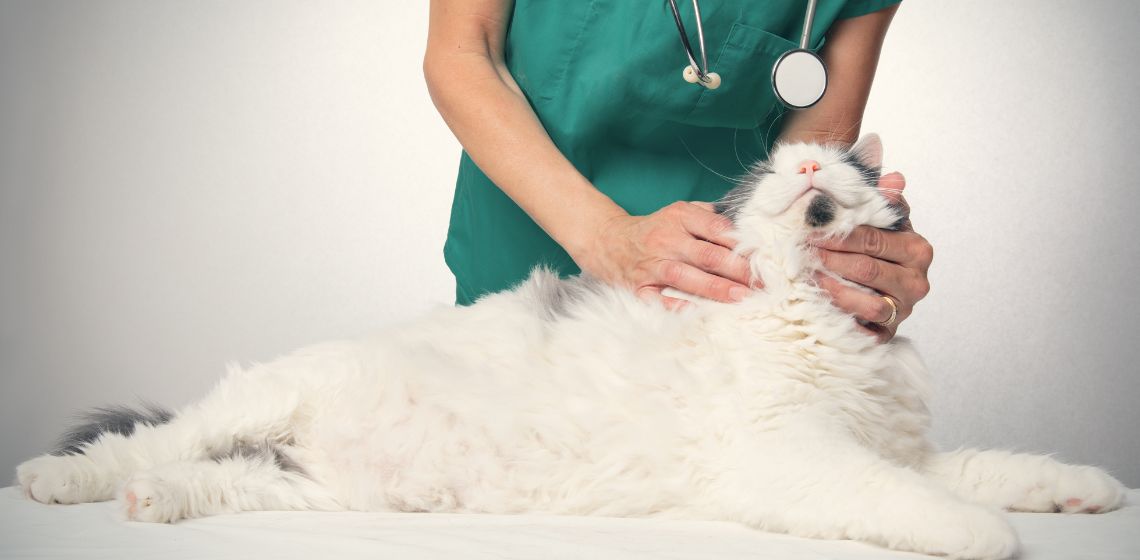Table of Contents
Why indoor cats need to see the vet
While indoor cats are certainly safer from outdoor hazards like cars and predators, they are not immune to health problems. Conditions such as cancer, diabetes, hyperthyroidism, dental disease, and kidney disease are common in cats and occur regardless of whether or not your cat goes outdoors. As cats are masters at hiding pain and illness, regular checkups are important for your vet to detect subtle signs of underlying health issues that you may not notice at home. Additionally, even indoor cats need preventative care at least once a year. Vaccinations protect them from deadly contagious diseases that can be brought into the home. Regular parasite control is also essential, as fleas and other parasites can easily find their way indoors. Regular vet visits also help foster a strong relationship between your cat, you, and your veterinarian. This familiarity makes your cat more comfortable during exams and allows your vet to become well-acquainted with your cat’s health history — critical factors if your cat does become ill.Preventative care for indoor cats
Preventative care is essential for maintaining the health and well-being of indoor cats. While this can encompass anything from vaccines to nutrition and weight management, the following are especially important, regardless of your cat’s lifestyle.Vaccines
Core vaccines are recommended for all cats because they protect against diseases that are widespread, highly infectious, and severe/life-threatening. Non-core vaccines are recommended for some cats based on individual risk factors, such as location, age, and lifestyle. So, while indoor-only cats may need fewer vaccines than those who go outdoors, they are still critical for keeping your cat healthy. Core vaccines for cats include FVRCP, FeLV (for those under one year of age), and Rabies. The Rabies vaccine is generally required by law, but the specifics may vary by state. Rabies can be transmitted through contact with infected wildlife, such as bats, that may enter a home. Additionally, if your indoor cat escapes or is accidentally exposed to a rabid animal, being vaccinated can save their life.Parasite prevention
Unfortunately, several types of parasites can affect indoor cats, and some of them can lead to spread of disease in both humans and animals. Intestinal parasites, such as roundworms, tapeworms, and hookworms, are common and may cause health issues such as vomiting, diarrhea, and weight loss. Heartworm, which affects the heart and lungs, is transmitted through mosquito bites and can be fatal in cats. Fleas are an extremely common external parasite. Not only can they be brought indoors on clothing or other pets, but a large part of their lifecycle takes place in your home, where they burrow into carpets and furniture. Fleas can cause itching, skin irritation/infection, and even anemia. Regular veterinary checkups and fecal examinations are important for keeping your cat free of parasites. Monthly flea/tick and heartworm prevention is recommended even for indoor cats. Maintaining good hygiene in your cat’s living area, washing bedding regularly, and vacuuming frequently can also help reduce the risk of parasite transmission. Additionally, preventing your cat from hunting or eating rodents can further minimize their exposure to certain parasites.Screening tests
As part of an annual exam, your veterinarian may recommend several screening tests, depending on your cat’s age and health. These tests are vital for early detection of underlying health conditions. Early intervention significantly improves treatment outcomes and can even extend your cat’s lifespan. Screening tests often include blood and urine tests to help evaluate overall health, major organ function, and fecal examination for parasites. Consult with your veterinarian about the specific tests recommended for your cat.Common medical issues in indoor cats
Regardless of whether or not your cat goes outdoors, there are certain medical conditions that they may face in their lifetime. In 2023, Nationwide (a pet insurance group) analyzed over 1.43 million claims to identify the most common medical conditions impacting our pets. The top 10 diseases in cats prompting veterinary visits included chronic kidney disease, cystitis, gastropathy, enteropathy, hyperthyroid disease, dental disease, diabetes, atopic or allergic dermatitis, upper respiratory infection, and otitis externa. It’s important to monitor your cat closely and alert your vet to any new physical or behavioral symptoms, such as changes in thirst and urination, appetite, bowel movements, vomiting, coughing, itchy skin, and weight loss. Now let’s take a closer look at a few issues that may be especially common in indoor-only cats.Obesity
Obesity is common in indoor cats, due to a less active lifestyle and easy access to food. Obesity can lead to serious health problems like diabetes, arthritis, heart disease, and respiratory issues. But your indoor cat doesn’t have to be overweight. Maintaining a healthy body condition through portion control, a balanced diet and regular exercise is vital for your cat’s well-being.Dental disease
Dental disease is extremely common in cats, affecting 50-90% of felines over four years of age. Plaque and tartar buildup leads to gingivitis, periodontal disease, tooth loss, infection, and even systemic disease. Cats are also prone to developing painful resorptive lesions. Regular dental care, including professional cleanings with your vet and at-home brushing, is the best way to prevent dental disease.Behavioral concerns
Cats can experience stress and anxiety due to boredom, lack of environmental enrichment, and changes in routine, among other things. Stress can manifest in various ways, including behavioral problems like excessive grooming, aggression, scratching, and inappropriate urination. Providing mental and physical stimulation, along with a safe and comfortable environment, is essential for reducing stress in indoor cats. See the Indoor Pet Initiative for enrichment ideas for your indoor cat, and consult your vet about any behavioral concerns.Other myths about indoor-only cats
There are many myths surrounding cats, and some of them can actually be damaging to our feline friends. For example, the myth that black cats are bad luck has harmed black cat adoptions from animal shelters. Let’s examine a few others regarding indoor-only cats.My indoor cat can’t get fleas or parasites
This is untrue. Fleas, mosquitoes (spreaders of deadly heartworm disease), and other parasites can easily be brought into your home on your clothing, shoes, other pets, or rodents. Regular preventative treatments are essential for protecting your indoor cat from parasites.Indoor cats will be bored
While cats are natural explorers and hunters, their needs can be adequately met within the confines of a home with proper enrichment and stimulation. Boredom in cats is often a result of a lack of environmental stimulation, not simply being indoors. By providing interactive playtime with toys that mimic hunting behaviors, creating a stimulating environment with climbing structures and scratching posts, offering food puzzles, and ensuring access to window views, you can help prevent boredom. Spending quality time with your cat, petting, grooming, and playing with them, also helps fulfill their social needs. If you feel like your cat is still missing the great outdoors, you could invest in a catio or take them out on a harness and leash.Indoor cats don’t need to be microchipped
While indoor cats are less likely to wander off than outdoor cats, accidents can happen, especially as cats tend to be great escape artists. Microchipping is a safe, simple, and permanent way to identify your cat and help reunite you if they get out.Indoor cats only need one litterbox
The general rule-of-thumb is to have one more box than the number of cats you have, therefore a single-cat home should have two litter boxes, ideally located in different locations.FAQ
This depends on your cat’s age and health. Kittens need to see the vet frequently, as they require vaccines every 3-4 weeks until at least 16 weeks of age. Healthy adult cats should see the vet at least once a year, and seniors (over 7-9 years of age) every 6 months. Cats with chronic medical conditions will likely need to see the vet more frequently.
If your cat hasn’t been to the vet in a while (or even if they have), it’s normal for them to experience stress and anxiety. To help minimize this, it’s important to prepare ahead for the vet by finding a cat-friendly and fear-free clinic, asking your vet about medications such as gabapentin to reduce stress beforehand, letting your cat get familiar with their carrier, and using calming pheromone sprays such as Feliway.
With The Vets, there’s no need to stress indoor cats by putting them into carriers and taking them to a vet clinic full of other pets. Our teams come to you and perform all the necessary procedures, treatments, and exams in the place where your cat feels most comfortable – at home.
Yes, even indoor cats need core vaccines. While they may be less exposed to certain diseases than outdoor cats, they are not immune. Some diseases can be brought into your home on your clothing/shoes, by other animals, or through the air, and indoor cats can sometimes escape. Vaccines protect your cat from serious and potentially deadly diseases, including rabies (often required by law), panleukopenia (feline distemper), feline herpesvirus and calicivirus (upper respiratory infections). Talk to your vet to determine the best vaccination schedule for your indoor cat.

Liza is a veterinarian who graduated from MSU CVM in 2013 and spent five years working in small animal practice. She loved working with dogs and cats and educating owners on all aspects of veterinary medicine, especially animal behavior and dermatology. She has since transitioned to remote work to be able to spend more time at home with her husband, two young kids, and two cats. She is thrilled to be able to combine her passions for veterinary medicine and writing. She is licensed as a veterinarian in Washington State.








